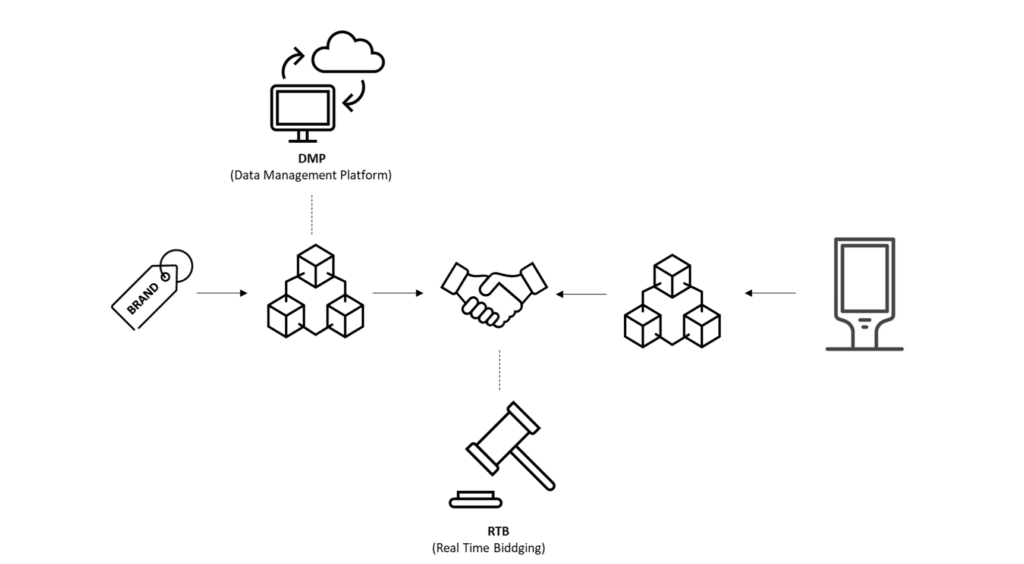How do I book a pDOOH campaign?
Since 2021, we offer the possibility to buy DOOH campaigns programmatically, to plan and optimise them in real time and to handle them. With the availability of our entire DOOH inventory on various DSPs, you can target your campaigns precisely. Automated access to our inventory gives you full transparency and influence over your booking. With Programmatic DOOH we offer you fast reach build-up, relevant touchpoints for anchoring the message, maximum flexibility and dynamic playout.
There are several ways to allocate pDOOH inventory for a campaign. The most common type is open real-time bidding or ‘auction bidding’, where a slot is offered to a group of bidders who each specify an amount they would pay for it. Within milliseconds, the best bid is deemed the winner and the spot/ad is placed. At Clear Channel, we offer two variations of deals.
Private Auction / Evergreen Deal
Clear Channel offers action options based on the different segments – Street, Malls, Convenience, Airports. In addition, there is the possibility to target your alcohol, tobacco and political advertising where it is allowed, based on whitelists. You can download an overview of the campaigns here.
Preferred Deal
With Preferred Deals, we set a price for you based on your briefing and can give you special access to the inventory. This gives you first rights to our inventory in an auction-like setting. In this case, send your campaign briefing to pdooh@clearchannelch.atlassian.net or to your contact at Clear Channel Switzerland.
Programmatic Guaranteed
Programmatic Guaranteed Deals are also a 1:1 relationship between the buyer and Clear Channel, except that we guarantee volume in addition to the guaranteed fixed price.
For more information on briefing, planning, execution and evaluation of a pDOOH campaign, pricing and offers, download our Programmatic Guide here.
Let’s take a step back and look step by step before you decide on a deal type
The term “Programmatic” refers to the computerised, automated buying and selling of advertising space. It uses targeting tactics to segment audiences so that advertisers only pay for ads that are delivered to the right people at the right time.

Above you will find a simplified version of the programmatic process where advertisers/agencies are on the “buy side” and marketers, in this case Clear Channel, are on the “sell side”. There are some elements that are still listed here as they are involved in the process or exchange, such as the management of so-called audience data and the measurement of campaigns. This will be discussed in another post. Here we would like to guide you as a starter “step by step” through the planning and buying process if you are just starting out with Programmatic.
Step 1: Campaign planning
a. Define your campaign goal
Every campaign must have a defined objective or main goal. This way, marketers can focus on the purpose of their campaigns and clarify your reporting and focus on the appropriate metric to measure KPI and ROI.
b. Define your target group
Choosing the right target group is crucial as it will determine the course of your campaign.
The target audience should correspond to the people who are likely to find your offer attractive based on their profile, location, habits, tastes and preferences. It is also important to consider how many people belong to this target group to avoid wasting time or money focusing on an insufficiently large target market.
Using pDOOH, you can target customised audiences on a granular and behavioural level on selected screens in the real world. Using anonymised location-based data, such as mobile location data, you can find out where your target group is likely to be at any given time. The target audience should correspond to the people who are likely to find your offer attractive based on their profile, location, habits, tastes and preferences. It is also important to consider how many people belong to this target group to avoid wasting time or money focusing on an insufficiently large target market.
So pDOOH is used to buy advertising space and activate screens wherever a significant number of people in a target group are present to ensure they are reached with timely and relevant messages.
c. Where do you reach your audience?
This is crucial for a DOOH campaign: you need to understand and match the needs and buying behaviour of your target audience at a particular location. It is also important to know where your target customers are, how often they pass by a particular DOOH and when is the optimal time to present your DOOH.
Step 2: Subject / Video
Now that the campaign objectives have been defined and the target groups identified, the next step is to create the promotional material. The promotional material plays an important role in the success of the campaign to attract the attention of the users and to trigger actions.
Video content predominates in DOOH campaigns. Branded videos are recommended and usually used for DOOH, but are inevitably expensive to produce. Regardless of which medium you use, the goal of an ad placement is to trigger an action or reaction.
Therefore, with every medium, make sure that the content meets these criteria:
- A clear message
- A direct call to action
- Visuals that are striking, catchy and not too complicated (for more information on design, see this link)
To be even more creative or responsive, you can combine Dynamic Creative Optimisation (DCO) with DOOH. Research has shown that contextual DOOH messages increase overall effectiveness across all metrics by 49%, drive a 30% increase in action, sales, consideration and awareness, and a 44% increase in behaviour change. Contextual Digital OOH advertising ensures that your campaign remains relevant in multiple locations and conditions. Translated with www.DeepL.com/Translator (free version)
Now you are ready to go – you just have to decide where you want to plan your campaign and which parameters you want to take into account – budget, timings, locations, etc.
Step 3: Selecting the Demand Side Platform (DSP)
To be able to buy digital advertising inventory from us programmatically, you need access to a DSP (Demand Side Platform).
When choosing a DSP, you should consider that not all DSPs offer access to DOOH publishers and that they have different partnerships with data collection companies (which affects targeting options). You can find out which DSPs are already connected and tested with us at the following Link.
Step 4: Progammatic buying at CC
Clear Channel Switzerland currently offers three different options – Private Marketplace (PMP), Programmatic Guaranteed, and Preferred Deals.
You can find our PMP Deals here. You don’t necessarily have to contact us for these. You work directly with your chosen DSP to determine your target group, your CPM budget (cost per thousand impressions) and much more.
For a Programmatic Guaranteed Deal or a Preferred Deal, contact our Programmatic Team.
You bought your first DOOH slot and now?
Once your ad is up, you can start tracking and reporting on the performance of your campaign with the help of your DSP. A big advantage of programmatic buying is that you can easily adjust your campaign over time to optimise its effectiveness.
And what else is coming?
Although this is meant to be an introduction to buying a pDOOH campaign, we will delve deeper into types of programmatic buying, measuring campaign effectiveness and much more from the Programmatic realm. Stay tuned and look out for our next issue.
